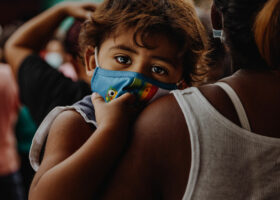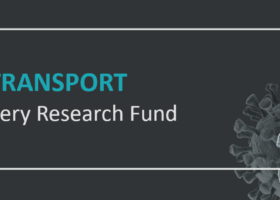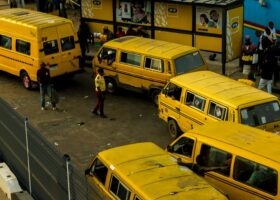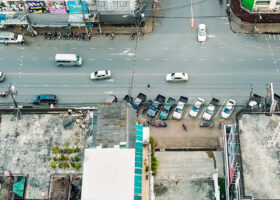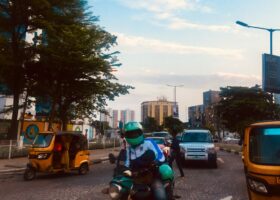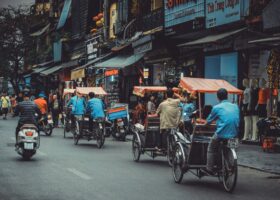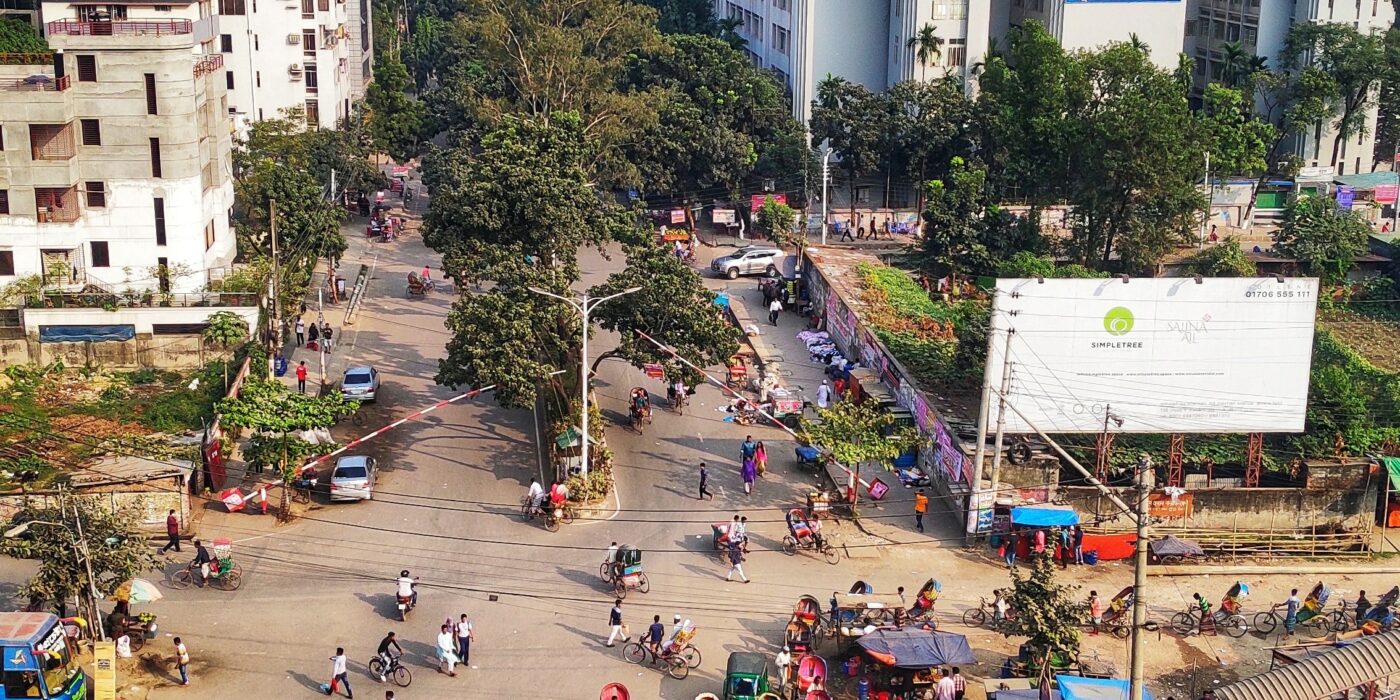
Overview
Introduction Concerns have been raised about the potential for risk compensation in the context of mask mandates for mitigating the spread of COVID-19. However, the debate about the presence or absence of risk compensation for universal mandatory mask-wearing rules—especially in the context of COVID-19—is not settled yet.
Methods Mobility is used as a proxy for risky behaviour before and after the mask mandates. Two sets of regressions are estimated to decipher (any) risk-compensating effect of mask mandate in Bangladesh. These include: (1) intervention regression analysis of daily activities at six types of locations, using pre-mask-mandate and post-mandate data; and (2) multiple regression analysis of daily new COVID-19 cases on daily mobility (lagged) to establish mobility as a valid proxy.
Results (1) Statistically, mobility increased at all five non-residential locations, while home stays decreased after the mask mandate was issued; (2) daily mobility had a statistically significant association on daily new cases (with around 10 days of lag). Both significances were calculated at 95% confidence level.
Conclusion Community mobility had increased (and stay at home decreased) after the mandatory mask-wearing rule, and given mobility is associated with increases in new COVID-19 cases, there is evidence of risk compensation effect of the mask mandate—at least partially—in Bangladesh.
Publications with the same themes
Publications with the same study countries
Related news & events
News
News
News
News
Blog
News
Blog
PDF content (text-only)
Skip to main content BMJ Journals Log In Basket Search for this keyword search Advanced search BMJ Global Health Latest content Archive Authors About Blog Supplements You are here Home Archive Volume 7, Issue 1 Email alerts Article Text Article info Citation Tools Share Rapid Responses Article metrics Alerts Download PDFPDF Download PDF + Supplemental DataPDF + Supplementary Material Original research Face mask mandates and risk compensation: an analysis of mobility data during the COVID-19 pandemic in Bangladesh http://orcid.org/0000-0003-2692-8299Zia Wadud1, http://orcid.org/0000-0002-3174-856XSheikh Mokhlesur Rahman2, http://orcid.org/0000-0002-5463-6202Annesha Enam2 Correspondence to Dr Zia Wadud; Z.Wadud@leeds.ac.uk Abstract Introduction Concerns have been raised about the potential for risk compensation in the context of mask mandates for mitigating the spread of COVID-19. However, the debate about the presence or absence of risk compensation for universal mandatory mask-wearing rules—especially in the context of COVID-19—is not settled yet. Methods Mobility is used as a proxy for risky behaviour before and after the mask mandates. Two sets of regressions are estimated to decipher (any) risk-compensating effect of mask mandate in Bangladesh. These include: (1) intervention regression analysis of daily activities at six types of locations, using pre-mask-mandate and post-mandate data; and (2) multiple regression analysis of daily new COVID-19 cases on daily mobility (lagged) to establish mobility as a valid proxy. Results (1) Statistically, mobility increased at all five non-residential locations, while home stays decreased after the mask mandate was issued; (2) daily mobility had a statistically significant association on daily new cases (with around 10 days of lag). Both significances were calculated at 95% confidence level. Conclusion Community mobility had increased (and stay at home decreased) after the mandatory mask-wearing rule, and given mobility is associated with increases in new COVID-19 cases, there is evidence of risk compensation effect of the mask mandate—at least partially—in Bangladesh. Data availability statement Both mobility and COVID-19 infections data are available in public, open access repositories. The rest is available upon reasonable request. http://creativecommons.org/licenses/by-nc/4.0/ This is an open access article distributed in accordance with the Creative Commons Attribution Non Commercial (CC BY-NC 4.0) license, which permits others to distribute, remix, adapt, build upon this work non-commercially, and license their derivative works on different terms, provided the original work is properly cited, appropriate credit is given, any changes made indicated, and the use is non-commercial. See: http://creativecommons.org/licenses/by-nc/4.0/. http://dx.doi.org/10.1136/bmjgh-2021-006803 Statistics from Altmetric.com Article has an altmetric score of 57 See more details Picked up by 7 news outlets Tweeted by 11 Mentioned in 1 Q&A threads 13 readers on Mendeley Supplementary materials Request Permissions If you wish to reuse any or all of this article please use the link below which will take you to the Copyright Clearance Center's RightsLink service. You will be able to get a quick price and instant permission to reuse the content in many different ways. Request permissions Key questions What is already known? A structured search on PubMed using the following search terms ('risk compensation' OR 'risk homeostasis') AND ('COVID19' OR 'COVID-19' OR 'covid19' OR 'covid-19' OR 'SARS CoV2' OR 'SARSCoV-2' OR 'SARS-CoV-2' OR 'SARS-COV2') AND ('face mask' OR 'face cover') revealed only two studies. One of these is a systematic review that strongly points to the lack of studies on risk compensation in the context of COVID-19 and mask use. The other newer study is the only peer-reviewed primary study reporting risk compensation effects of face mask mandates in the USA. A wider search (no 'face mask' in search term) reveals a further seven studies, none of which are primary studies investigating the risk compensation effects of face mask wearing or face mask mandates in the context of COVID-19. There are opinion and review pieces both cautioning against risk compensation effects and refuting the existence of risk compensation. What are the new findings? Given the lack of evidence specifically on face mask mandates and risk compensation in the context of COVID-19, this study adds value by providing new evidence and strengthens the evidence base on this topic. There is statistically significant evidence that mobility at out-of-home locations had increased and stay at home had decreased since the mandatory mask rule was implemented in Bangladesh. Since mobility is linked to daily new COVID-19 cases, the results suggest the existence of risk compensation effect of mandatory mask mandates. The geographic coverage from a developing country is also a significant addition to knowledge, given the global nature of the pandemic and the need for a globally coordinated response. Key questions What do the new findings imply? In conjunction with an earlier study in the USA, the findings provide robust evidence of increases in mobility after mask mandates, suggesting the presence of risk compensation. This can be important in policy design. Future research needs to focus on quantifying the compensating effects, whether it is partial (in which case mask mandates are still beneficial and recommended), or full (in which case mask mandates are less effective), or overcompensating (in which case mask mandates are detrimental). Introduction There is now increasing evidence from laboratory and observational studies that face coverings, when worn correctly, can reduce the transmission of SARS-CoV-2, popularly known as COVID-19.1–5 Despite some initial caution in the early stages,6 the use of face coverings or face masks is now recommended or mandated in more than 160 countries in the world as a measure to reduce the transmission of the virus.7 One of the reasons for the earlier caution was the concern about risk-compensating behaviour, whereby mask wearing could encourage people to undertake other activities that could increase the risks for transmission and thus could reduce or nullify the beneficial effects of wearing masks.6 8 However, even after more than one-and-a-half year since the first detection of COVID-19, there is limited evidence on the potential behavioural changes enabled by the perceived sense of safety arising from the mandatory mask-wearing regulation. A recent systematic review suggests 'Any new research on face masks should assess and report the harms and downsides, including behavioural issues (ie, risk compensation behaviour [emphasis added]) ….'.9 This research addresses this gap by modelling the effects of mandatory mask regulations on mobility, where (potential) increases in mobility are used as an indicator for risk-compensating effects. The hypothesis is that the sense of safety offered by the mandatory mask use regulation may encourage people to take more risks and allow them to venture out of homes more. Methods Data Mobility is chosen as the metric to study risk compensation in this study. Daily aggregated mobility activity data for different activity locations in Bangladesh were collected from Google Community Mobility Reports.10 Google collects the data from its Android phones with location history turned on, and aggregates the number of visits to different types of locations in a region, country or city. Data for six types of locations in Bangladesh are available—retail and recreation (restaurants, cafes, shopping centres, museums, libraries, cinemas), grocery and pharmacy (supermarkets, bazaars, specialty food shops, food warehouses and pharmacies), parks, transit stations, workplaces, and residences. The out-of-home mobility and activity changes were calculated as the percent differences in the number of visitors compared with a baseline. For residential activity, percentage changes in the number of hours spent at home were reported. The baselines were median values for the corresponding days of the week from 3 January 2020 to 6 February 2020. As such, within-week daily variations in travel pattern are already cancelled out. As figure 1 shows, little variation around the baseline was noted from mid-February until mid-March which was followed by a sudden drop due to the closure of educational institutions, and then shopping malls, offices and transit operations in quick succession. After that, as the restrictions on operations were removed or relaxed, mobility started to gradually increase and recovered to pre-COVID-19 interruptions by October 2020. Figure 1 Download figure Open in new tab Download powerpoint Figure 1 Percentage changes in mobility from a baseline in Bangladesh. The vertical lines represent non-pharmaceutical interventions (see figure 3). Data source: Google Community Mobility Reports.10 Daily new COVID-19 cases for Bangladesh were collected from databases made available by Institute of Epidemiology, Disease Control and Research (IEDCR), Government of Bangladesh,11 and are presented in figure 2. Due to some discrepancies in early-period data, data from 1 April 2020 are used in this study. This also allows for the ramping up of testing compared with very few tests conducted in the early days. Descriptive statistics of the data are reported in online supplemental table S1. Supplemental material [bmjgh-2021-006803supp001.pdf] Figure 2 Download figure Open in new tab Download powerpoint Figure 2 Number of daily new COVID-19 cases in Bangladesh for the period between 1 April 2020 and 31 October 2020. The vertical lines represent non-pharmaceutical interventions (see figure 3). Data source: IEDCR, Government of Bangladesh.11 Figure 3 Download figure Open in new tab Download powerpoint Figure 3 Non-pharmaceutical interventions (NPIs) in response to COVID-19 first wave in Bangladesh. Modelling strategy All six aggregate Google mobility metrics are used to conduct six intervention analyses12 using the introduction of universal mask mandate as the intervention point. There were several interventions in a relatively short period of time in Bangladesh (eg, closure of educational institutions, shops, garment factories, offices and public transport, and then relaxing the closures in a staggered time frame, figure 3). Although the wearing of mask was recommended in some government-issued advisories earlier, any effects of those advisories cannot be separated from other concurrent interventions, also those other interventions received more media and public attention. The mandatory use of face coverings everywhere out of home was announced in the afternoon of 21 July, which is of key interest in this study. This announcement also received widespread media attention, indicating wide dissemination of the policy. Fortunately, there was a 7-week period (1 June to 21 July) before the mandatory mask regulation where no new nationwide interventions or relaxation of old interventions was announced, allowing the use of intervention analysis without substantial interference from other policies. While there were a few other interventions during this period, they were very local, covering very small segments of population for very few days to have any discernible effect on the overall national aggregate numbers. In the intervention modelling approach, the following steps are taken: (1) an Autoregressive Moving Average (ARMA) time-series model13 is estimated using the preintervention data (2 June to 21 July), (2) the estimated model is used to predict the values from 22 July to act as counterfactual, and (3) the predicted mobility values (counterfactual) are compared with actual values to test any systematic differences, which can be interpreted as the effect of the intervention. The comparison of predictions and actual mobility was done on data from 22 to 28 July (7 days), stopping 4 days before the Eid-ul-Adha on 1 August—a religious festival—in order to avoid the potential changes in mobility due to that particular event. The six ARMA models (models 1a–1f) have the following basic functional form: Embedded Image Here, Mit is the changes in mobility of type i (i=6 activity location types) at time t, and ɛit is the error. Residual autocorrelation, partial autocorrelation and normality of errors were used to choose the appropriate order of autoregressive (p) and moving average error (q) components. To capture the effects of weekends on the changes in mobility, an indicator variable (W) was added to the model. The data were trend stationary, so a linear time trend T was added to the ARMA model. The models were estimated separately for each i using the arima function in Stata.14 In order for mobility to be a valid metric for risk compensation, it is necessary to establish that an increase in mobility has a direct correlation with an increase in COVID-19 transmission. Several studies in various countries have well established this relationship using empirical data on various COVID-19 metrics and mobility metrics.15–18 Nonetheless, a second set of regressions are run for daily new cases on lagged daily mobility (models 2a–2f) using a longer time series (10 April to 31 October) for Bangladesh. Mobility is lagged in order to account for the time required from the changes in activities and associated interactions to incubation of the virus in human hosts, symptom recognition, testing and obtaining test results. The following regression is run: Embedded Image Here, Ct is daily new COVID-19 cases at time t, Mit is the mobility of type i (i=6 activity location types) at time t, ɛit is the error and l=days lagged between mobility measure and new COVID-19 cases. Number of tests was low on Eid days (religious festivals—indicator variable, E), weekends (indicator variable, W) and after the imposing of a fee for testing at government facilities (indicator variable, F, lagged by 3 days to account for the test to result delay). Three trends, T1, T2 and T3 were added to capture the three distinct trends (10 April to 2 July, 3 July to 30 September and 1–31 October 2020) that were observed in daily new cases (figure 2). These trends are identified based on the abrupt changes in slope direction of the daily new cases (online supplemental figure S1). The final model is chosen based on model fit (adjusted R2, Akaike Information Criterion-AIC, Bayesian Information Criterion-BIC), and robust standard errors (SEs) were used to tackle potential residual autocorrelation among errors. Separate models were estimated for each type of mobility measure (i). Together, these two sets of regressions would establish (or not) mobility as an important predictor of the COVID-19 infections and risk compensation. Although it can be argued that daily new cases can also be directly regressed against (lags of) various policy interventions (including mandatory mask use), that model can point to risk compensation only if full compensation or overcompensation was realised. Results Effects of mask mandate on mobility outcome The estimated ARMA models (1a–1f) and diagnostic tests for the six mobility metrics are reported in online supplemental table S2. Each of the six mobility metrics in models 1a–1f shows a statistically significant divergence at 95% or above confidence level between the predicted and the actual activities at those locations (table 1, also see online supplemental figure S2). Of these, five—retail and recreation, grocery and pharmacies, workplaces, parks and transit hubs—show larger actual activities after the compulsory mask-wearing mandate (smaller reduction from baseline) than predicted by the model (counterfactual for no mandatory mask intervention). At the same time, actual residential activities were statistically smaller than predicted values. These six sets of results all lead to the same conclusion that out-of-home activities had increased since the mandatory mask-wearing rule. Among the out-of-home activities, activities at workplaces show the smallest divergence between actual and predicted values. Given work travel is a necessity, it is likely that people started to return to work even before mask use was made mandatory. Indeed, the offices were already allowed to operate at half capacity from 31 May 2020 encouraging work travel. As such, the additional effect of the mask mandate for work destinations was always expected to be less compared with other destinations. On the other hand, retail and recreation, grocery and pharmacies, parks and transit hubs show the largest divergence between predicted and actual activities—these often represent discretionary trips which could be avoided during the times of emergency like the pandemic and therefore had the largest potential to rebound as a result of the mask mandate, as the results confirm, too. VIEW INLINE VIEW POPUP Table 1 Divergence in model-predicted and observed mobility measures for the period between 22 and 28 July 2020 Falsification tests are conducted by running new models where the date for mandatory mask intervention was brought forward by 1 and 3 days as placebos. Differences in the 7-day predictions with actual activities for all six mobility indicators become statistically insignificant for both these cases (online supplemental table S3), showing the effects of the actual intervention were not spurious. Also, in order to test the robustness of the prediction model itself, the data were divided into training, validation and prediction set (online supplemental table S4 and online supplemental figure S3). The model was estimated using the training set (2 June to 14 July), validated using the validation set (14–21 July, which showed no systematic divergence) and then used for prediction comparison (22–28 July), which again revealed statistically significant divergence between observed and predicted mobility measures. This shows that the findings are not spurious and suggests a potentially causal effect of the mask mandate on mobility. Effects of mobility measures on COVID-19 infections Results from models 2a–2f in table 2 show that mobility is statistically associated with new COVID-19 cases in Bangladesh, suggesting mobility was indeed a useful metric to study risk compensation in this context. A lag of around 10 days between the mobility metric and new cases best fitted the data, which falls within the range observed in the literature.19–22 Online supplemental table S5 presents the best models obtained by varying lag between the mobility metric and new cases, which also show a similar pattern. Despite some concerns about the quality of COVID-19 infection data in Bangladesh, the results here support previous findings on the association between mobility and COVID-19 transmission in other countries.18–21 VIEW INLINE VIEW POPUP Table 2 Parameter estimates for the association between mobility and COVID-19 infection A separate model to quantify the relationship of COVID-19 infections with external interventions (such as policies or Eid festivals) was also estimated using mask mandate as an intervention (online supplemental table S6). However, since the impact of the mask mandate on infections also depends on the degree and quality of adherence to the mask mandate policy, those results cannot be interpreted as risk compensation only. Also, while the effect of a policy does not appear on a precise day (and is rather distributed), lack of disaggregate case data prevents us from exploring those effects and the lag used can be taken as a mean of that distribution. Discussion Risk-compensating hypothesis was originally developed by economists while studying the effects of regulations to increase motor vehicle safety23 and is closely related to the 'risk homeostasis' hypothesis in psychology.24 Together, these hypotheses suggest that people have a target level of perceived risk, and they act to keep that level of risk constant; as a result, any intervention that reduces the risk of an activity may be compensated by risk-taking behaviour of another type. This compensating behaviour could reduce (partial compensation) or completely nullify (full compensation) the intended benefits of the intervention, with practical implications for the actual effectiveness of the intervention. Due to its importance for intervention design in practice, risk compensation has attracted significant attention among researchers, who study the presence or absence of the effects in diverse areas. These include motor vehicle regulations to improve occupant and non-occupant safety,23 25 helmet regulations to improve bicycle rider safety,26 27 human papillomavirus vaccination to prevent cervical cancer28 29 and pre-exposure prophylaxis to prevent HIV infections.30 Detail discussion of this literature is beyond the scope of this research, but reviews by others tend to agree that the evidence in favour of the hypothesis is rather thin in these areas.29 31–33 This does not necessarily prove that risk compensation would be absent in other areas, such as mask mandates, since these are all very different types of interventions. Indeed, the four influencing factors—visibility of the intervention, effects on a person, motivation to change behaviour, and ability (control) to change behaviour—that have been proposed to explain the existence and extent of risk-compensating behaviour can be affected very differently by different types of interventions.34 As Hedlund34 concludes in his well-balanced appraisal of risk compensation, 'Never assume that behaviour will not change.' To this end, concerns have been raised about the potential risk-compensating effects of COVID-19 vaccination, too.35 More pertinent to this study are six experimental studies investigating the effects of face masks for managing viral respiratory infections.36–41 These studies found that the wearing of masks did not reduce the frequency of hand washing or hand sanitising, which were taken as measures of risky behaviour. In the context of COVID-19, risk-compensating behaviour of mask use was not observed in a UK study based on a self-reported response to a questionnaire survey.42 However, none of these studies were designed to elicit risk-compensating behaviour. Also, interpreting the difference between two groups of people (mask users and non-users) at around the same time as changes in behaviour pre-mask and post-mask mandate, as done in some of these studies,40 41 43 is flawed. In the mobility and travel space, risk compensation in the context of mask mandates for COVID-19 can manifest in different ways, for example, by increasing more contact with people, by reducing the distances maintained while walking or queueing, or by increasing travel-related activities in general. At least one study found an overall increase in the number of contacts after face covering interventions in Denmark, supporting the risk compensation hypothesis.44 Two studies did not find any reduction in the interpersonal distances in queues after the mandatory mask rules in Germany and Italy,45 46 but another stated preference experiment suggests that participants were willing to reduce their walking or queueing distances from strangers if either was wearing a mask.47 Yet another observational study found mixed evidence on distancing in Denmark, depending on the type of locations.44 In Bangladesh, the effects of nudges and interventions on mask usage and interpersonal distances were studied (interpersonal distances increased due to nudges), but not directly the risk compensation effects of mask mandates.48 At the time of writing, all of these studies were not peer reviewed, so it is difficult to draw robust conclusions from this literature; however, it appears that the evidence is mixed both for number of contacts and interpersonal distances. The only peer-reviewed work on the effects of mask mandates on mobility or travel activities supports the risk compensation hypothesis.49 That study also used location data from smart devices to report an increase in the number of visits to public places (restaurants, parks, health and personal care, etc) and a reduction in home-dwelling time in the USA after the mask mandate.49 A non-peer-reviewed study analysed Google mobility data (similar to the current study) to report no such increases in mobility in Germany,50 yet, the simultaneity of the mandatory mask policy with other policies in that study makes that conclusion less reliable. Nonetheless, whether these differences in risk compensation exist between countries and what drives these differences (eg, methods, data, compliance culture, enforcement strictness, pandemic stage) in different regions of the world is an important area of future research. It can be argued that what is measured in this study is not risk compensation per se, that is, people in Bangladesh did not intentionally increase their mobility because masks offered them protection, instead, they may have viewed the mask mandate as a sign for returning to some form of normalcy. As such the 'signal' effect cannot be separated from the actual risk-compensating behaviour. However, from a policy-making perspective, the distinction is possibly not very important. What is important is whether the mask mandate had increased mobility and thus was likely to have reduced at least some of the benefits expected from the mask use rule. The evidence in favour of increased mobility, which in turn is correlated with increased COVID-19 transmission, is strong—both in this study and the only other peer-reviewed work on the topic.49 In the context of risk compensation, the more important question is 'not yes or no, but when and how much'.34 Public health decision makers will be more interested in knowing whether the additional mobility (or risky behaviour) is large enough to entirely offset the beneficial effects of wearing face coverings. If not, the net effect is still beneficial and the mandatory mask intervention still remains desirable. On the other hand, even if risk compensation is partial, in marginal scenarios small increases in mobility (or risky behaviour) across the population could be the difference between an exponential growth and the containment of the pandemic.49 Indeed, our exploratory analysis (online supplemental table S6) hints at the possibility that inadequately administered mask mandates may have nullified the expected benefits of mask wearing in Bangladesh. As such, it is important that constant nudges and incentives are provided to ensure adherence to mask wearing,48 rather than simply issuing a mask mandate without robust enforcement and implementation. Further research is also needed to precisely quantify the risk compensation effects of mask wearing and inadequate implementation effects of mask mandates in the context of COVID-19 in order to avoid potential overprediction of the intended beneficial impacts of mask mandates. Data availability statement Both mobility and COVID-19 infections data are available in public, open access repositories. The rest is available upon reasonable request. Ethics statements Patient consent for publication Not required. Ethics approval This study does not involve human participants. Acknowledgments The authors thank Dr Mahbubur Rahman, Dr Suman Ahmed and Tali Trigg for stimulating discussion. References ↵Mitze T, Kosfeld R, Rode J, et al. Face masks considerably reduce COVID-19 cases in Germany. Proc Natl Acad Sci U S A 2020;117:32293–301.doi:10.1073/pnas.2015954117pmid:http://www.ncbi.nlm.nih.gov/pubmed/33273115Abstract/FREE Full TextGoogle Scholar ↵Lyu W, Wehby GL. Community use of face masks and COVID-19: evidence from a natural experiment of state mandates in the US. Health Aff 2020;39:1419–25.doi:10.1377/hlthaff.2020.00818pmid:http://www.ncbi.nlm.nih.gov/pubmed/32543923CrossRefPubMedGoogle Scholar ↵Karaivanov A, Lu SE, Shigeoka H, et al. Face masks, public policies and slowing the spread of COVID-19: evidence from Canada. J Health Econ 2021;78:102475. doi:10.1016/j.jhealeco.2021.102475pmid:http://www.ncbi.nlm.nih.gov/pubmed/34157513CrossRefPubMedGoogle Scholar ↵Coclite D, Napoletano A, Gianola S, et al. Face mask use in the community for reducing the spread of COVID-19: a systematic review. Front Med 2020;7:594269.doi:10.3389/fmed.2020.594269pmid:http://www.ncbi.nlm.nih.gov/pubmed/33511141PubMedGoogle Scholar ↵Howard J, Huang A, Li Z, et al. An evidence review of face masks against COVID-19. Proc Natl Acad Sci U S A 2021;118:e2014564118. doi:10.1073/pnas.2014564118pmid:http://www.ncbi.nlm.nih.gov/pubmed/33431650Abstract/FREE Full TextGoogle Scholar ↵WHO. Mask use in the context of COVID-19: interim guidance. Report No.: WHO/2019-nCoV/IPC_Masks/2020.5. World Health Organization, 2020.Google Scholar ↵Mills M, Rahal C, Akimova E. Face masks and coverings for the general public: behavioural knowledge, effectiveness of cloth coverings and public messaging [Internet]. The Royal Society & The British Academy, 2020.Google Scholar ↵Cowling BJ, Leung GM, masks F. Face masks and COVID-19: don't let perfect be the enemy of good. Euro Surveill 2020;25:2001998. doi:10.2807/1560-7917.ES.2020.25.49.2001998pmid:http://www.ncbi.nlm.nih.gov/pubmed/33303063PubMedGoogle Scholar ↵Bakhit M, Krzyzaniak N, Scott AM, et al. Downsides of face masks and possible mitigation strategies: a systematic review and meta-analysis. BMJ Open 2021;11:e044364. doi:10.1136/bmjopen-2020-044364pmid:http://www.ncbi.nlm.nih.gov/pubmed/33619199Abstract/FREE Full TextGoogle Scholar ↵Google mobility report, 2020. Available: https://www.google.com/covid19/mobility/ [Accessed Nov 2020].Google Scholar ↵Corona Info of Government of Bangladesh, 2020. Available: https://corona.gov.bd/ [Accessed Nov 2020].Google Scholar ↵Bernal JL, Cummins S, Gasparrini A. Interrupted time series regression for the evaluation of public health interventions: a tutorial. Int J Epidemiol 2017;46:348–55.doi:10.1093/ije/dyw098pmid:http://www.ncbi.nlm.nih.gov/pubmed/27283160CrossRefPubMedGoogle Scholar ↵Box GE, Jenkins GM. Time series analysis. forecasting and control. Holden-Day series in time series analysis, 1976.Google Scholar ↵StataCorp. Stata statistical software: release 17. College Station, TX: StataCorp LLC, 2021: p. 733.Google Scholar ↵Lau H, Khosrawipour V, Kocbach P, et al. The association between international and domestic air traffic and the coronavirus (COVID-19) outbreak. J Microbiol Immunol Infect 2020;53:467–72.doi:10.1016/j.jmii.2020.03.026pmid:http://www.ncbi.nlm.nih.gov/pubmed/32299783PubMedGoogle Scholar ↵Nouvellet P, Bhatia S, Cori A, et al. Reduction in mobility and COVID-19 transmission. Nat Commun 2021;12:1090. doi:10.1038/s41467-021-21358-2pmid:http://www.ncbi.nlm.nih.gov/pubmed/33597546CrossRefPubMedGoogle Scholar ↵Cartenì A, Di Francesco L, Martino M. How mobility habits influenced the spread of the COVID-19 pandemic: results from the Italian case study. Sci Total Environ 2020;741:140489.doi:10.1016/j.scitotenv.2020.140489pmid:http://www.ncbi.nlm.nih.gov/pubmed/32599395CrossRefPubMedGoogle Scholar ↵Hadjidemetriou GM, Sasidharan M, Kouyialis G, et al. The impact of government measures and human mobility trend on COVID-19 related deaths in the UK. Transp Res Interdiscip Perspect 2020;6:100167.doi:10.1016/j.trip.2020.100167pmid:http://www.ncbi.nlm.nih.gov/pubmed/34173458CrossRefPubMedGoogle Scholar ↵Kraemer MUG, Yang C-H, Gutierrez B, et al. The effect of human mobility and control measures on the COVID-19 epidemic in China. Science 2020;368:493–7.doi:10.1126/science.abb4218pmid:http://www.ncbi.nlm.nih.gov/pubmed/32213647Abstract/FREE Full TextGoogle Scholar ↵Kuo C-P, Fu JS, . Evaluating the impact of mobility on COVID-19 pandemic with machine learning hybrid predictions. Sci Total Environ 2021;758:144151.doi:10.1016/j.scitotenv.2020.144151pmid:http://www.ncbi.nlm.nih.gov/pubmed/33316596PubMedGoogle Scholar ↵Lauer SA, Grantz KH, Bi Q, et al. The incubation period of coronavirus disease 2019 (COVID-19) from publicly reported confirmed cases: estimation and application. Ann Intern Med 2020;172:577–82.doi:10.7326/M20-0504pmid:http://www.ncbi.nlm.nih.gov/pubmed/32150748CrossRefPubMedGoogle Scholar ↵Linton N, Kobayashi T, Yang Y, et al. Incubation period and other epidemiological characteristics of 2019 novel coronavirus infections with right truncation: a statistical analysis of publicly available case data. J Clin Med 2020;9:538.doi:10.3390/jcm9020538Google Scholar ↵Peltzman S. The effects of automobile safety regulation. J Polit Econ 1975;83:677–725.doi:10.1086/260352CrossRefWeb of ScienceGoogle Scholar ↵Wilde GJS. The theory of risk homeostasis: implications for safety and health. Risk Analysis 1982;2:209–25.doi:10.1111/j.1539-6924.1982.tb01384.xCrossRefGoogle Scholar ↵Crandall RW, Graham JD. Automobile safety regulation and Offsetting behavior: some new empirical estimates. The American Economic Review 1984;74:328–31.Google Scholar ↵Lardelli-Claret P, de Dios Luna-del-Castillo J, Jiménez-Moleón JJ, et al. Risk compensation theory and voluntary helmet use by cyclists in Spain. Inj Prev 2003;9:128–32.doi:10.1136/ip.9.2.128pmid:http://www.ncbi.nlm.nih.gov/pubmed/12810738Abstract/FREE Full TextGoogle Scholar ↵Fyhri A, Bjørnskau T, Backer-Grøndahl A. Bicycle helmets – a case of risk compensation? Transportation Research Part F: Traffic Psychology and Behaviour 2012;15:612–24.doi:10.1016/j.trf.2012.06.003Google Scholar ↵Brewer NT, Cuite CL, Herrington JE, et al. Risk compensation and vaccination: can getting vaccinated cause people to engage in risky behaviors? Ann Behav Med 2007;34:95–9.doi:10.1007/BF02879925pmid:http://www.ncbi.nlm.nih.gov/pubmed/17688401CrossRefPubMedWeb of ScienceGoogle Scholar ↵Kasting ML, Shapiro GK, Rosberger Z, et al. Tempest in a teapot: a systematic review of HPV vaccination and risk compensation research. Hum Vaccin Immunother 2016;12:1435–50.doi:10.1080/21645515.2016.1141158pmid:http://www.ncbi.nlm.nih.gov/pubmed/26864126CrossRefPubMedGoogle Scholar ↵Rojas Castro D, Delabre RM, Molina J-M. Give PrEP a chance: moving on from the "risk compensation" concept. J Int AIDS Soc 2019;22 Suppl 6:e25351. doi:10.1002/jia2.25351pmid:http://www.ncbi.nlm.nih.gov/pubmed/31468693PubMedGoogle Scholar ↵Mantzari E, Rubin GJ, Marteau TM. Is risk compensation threatening public health in the covid-19 pandemic? BMJ 2020;370:m2913.doi:10.1136/bmj.m2913pmid:http://www.ncbi.nlm.nih.gov/pubmed/32713835FREE Full TextGoogle Scholar ↵Pless B. Risk compensation: revisited and Rebutted. Safety 2016;2:16.doi:10.3390/safety2030016CrossRefGoogle Scholar ↵Esmaeilikia M, Radun I, Grzebieta R, et al. Bicycle helmets and risky behaviour: a systematic review. Transportation Research Part F: Traffic Psychology and Behaviour 2019;60:299–310.doi:10.1016/j.trf.2018.10.026Google Scholar ↵Hedlund J. Risky business: safety regulations, risks compensation, and individual behavior. Inj Prev 2000;6:82–9.doi:10.1136/ip.6.2.82pmid:http://www.ncbi.nlm.nih.gov/pubmed/10875661FREE Full TextGoogle Scholar ↵Trogen B, Caplan A. Risk compensation and COVID-19 vaccines. Ann Intern Med 2021;174:858–9.doi:10.7326/M20-8251pmid:http://www.ncbi.nlm.nih.gov/pubmed/33646837PubMedGoogle Scholar ↵Cowling BJ, Chan K-H, Fang VJ, et al. Facemasks and hand hygiene to prevent influenza transmission in households: a cluster randomized trial. Ann Intern Med 2009;151:437–46.doi:10.7326/0003-4819-151-7-200910060-00142pmid:http://www.ncbi.nlm.nih.gov/pubmed/19652172CrossRefPubMedWeb of ScienceGoogle Scholar ↵Aiello AE, Perez V, Coulborn RM, et al. Facemasks, hand hygiene, and influenza among young adults: a randomized intervention trial. PLoS One 2012;7:e29744. doi:10.1371/journal.pone.0029744pmid:http://www.ncbi.nlm.nih.gov/pubmed/22295066CrossRefPubMedGoogle Scholar ↵Alfelali M, Haworth EA, Barasheed O, et al. Facemask against viral respiratory infections among hajj pilgrims: a challenging cluster-randomized trial. PLoS One 2020;15:e0240287. doi:10.1371/journal.pone.0240287pmid:http://www.ncbi.nlm.nih.gov/pubmed/33048964PubMedGoogle Scholar ↵Cowling BJ, Fung ROP, Cheng CKY, et al. Preliminary findings of a randomized trial of non-pharmaceutical interventions to prevent influenza transmission in households. PLoS One 2008;3:e2101. doi:10.1371/journal.pone.0002101pmid:http://www.ncbi.nlm.nih.gov/pubmed/18461182CrossRefPubMedGoogle Scholar ↵Simmerman JM, Suntarattiwong P, Levy J, et al. Findings from a household randomized controlled trial of hand washing and face masks to reduce influenza transmission in Bangkok, Thailand. Influenza Other Respir Viruses 2011;5:256–67.doi:10.1111/j.1750-2659.2011.00205.xpmid:http://www.ncbi.nlm.nih.gov/pubmed/21651736CrossRefPubMedGoogle Scholar ↵Larson EL, Ferng Y-hui, Wong-McLoughlin J, et al. Impact of non-pharmaceutical interventions on URIs and influenza in crowded, urban households. Public Health Rep 2010;125:178–91.doi:10.1177/003335491012500206pmid:http://www.ncbi.nlm.nih.gov/pubmed/20297744CrossRefPubMedGoogle Scholar ↵Guenther B, Galizzi MM, Sanders JG. Heterogeneity in risk-taking during the COVID-19 pandemic: evidence from the UK Lockdown. Front Psychol 2021;12:643653. doi:10.3389/fpsyg.2021.643653pmid:http://www.ncbi.nlm.nih.gov/pubmed/33868115PubMedGoogle Scholar ↵Cowling BJ, Ali ST, Ng TWY, et al. Impact assessment of non-pharmaceutical interventions against coronavirus disease 2019 and influenza in Hong Kong: an observational study. Lancet Public Health 2020;5:e279–88.doi:10.1016/S2468-2667(20)30090-6pmid:http://www.ncbi.nlm.nih.gov/pubmed/32311320PubMedGoogle Scholar ↵Jørgensen F, Lindholt MF, Bor A, et al. Does face mask use elicit risk-compensation? quasi-experimental evidence from Denmark during the SARS-CoV-2 pandemic. PsyArXiv 2020.Google Scholar ↵Marchiori M. Covid-19 and the social distancing paradox: dangers and solutions. arXiv preprint arXiv 2020:200512446.Google Scholar ↵Seres G, Balleyer AH, Cerutti N. Face mask use and physical distancing before and after mandatory masking: evidence from public waiting lines, 2020. ISBN: SSRN 3641367.Google Scholar ↵Luckman A, Zeitoun H, Isoni A, et al. Risk compensation during COVID-19: the impact of face mask usage on social distancing. OSF Preprints, 2020.Google Scholar ↵Abaluck J, Kwong LH, Styczynski A. Normalizing community Mask-Wearing: a cluster randomized trial in Bangladesh. National Bureau of Economic Research, 2021.Google Scholar ↵Yan Y, Bayham J, Richter A, et al. Risk compensation and face mask mandates during the COVID-19 pandemic. Sci Rep 2021;11:3174. doi:10.1038/s41598-021-82574-wpmid:http://www.ncbi.nlm.nih.gov/pubmed/33542386PubMedGoogle Scholar ↵Kovacs R, Dunaiski M, Tukiainen J. Compulsory face mask policies do not affect community mobility in Germany, 2020. ISBN: SSRN 3620070.doi:10.2139/ssrn.3620070Google Scholar Supplementary materials Supplementary Data This web only file has been produced by the BMJ Publishing Group from an electronic file supplied by the author(s) and has not been edited for content. Data supplement 1 Supplementary Data This web only file has been produced by the BMJ Publishing Group from an electronic file supplied by the author(s) and has not been edited for content. Data supplement 1 Footnotes Handling editor Seye Abimbola Contributors ZW led the overall study, including conceptualisation, acquisition of funding and writing. SMR and AE acquired and verified data, and reviewed and edited the paper. All three contributed equally to literature review, choice of methods, data analysis and interpretation of results. ZW takes responsibility for the end product. Funding This study was partially funded by UKAID through the Foreign, Commonwealth and Development Office under the High Volume Transport Applied Research Programme (HVT029.L1L094), managed by IMC Worldwide. The funding agency was not involved in conceptualising or design of methods, analysis of data or interpretation of results. The findings and conclusions contained within the article are those of the authors and do not necessarily reflect positions or official policies of the UK or Bangladesh Governments. Competing interests None declared. Provenance and peer review Not commissioned; externally peer reviewed. Supplemental material This content has been supplied by the author(s). It has not been vetted by BMJ Publishing Group Limited (BMJ) and may not have been peer-reviewed. Any opinions or recommendations discussed are solely those of the author(s) and are not endorsed by BMJ. BMJ disclaims all liability and responsibility arising from any reliance placed on the content. Where the content includes any translated material, BMJ does not warrant the accuracy and reliability of the translations (including but not limited to local regulations, clinical guidelines, terminology, drug names and drug dosages), and is not responsible for any error and/or omissions arising from translation and adaptation or otherwise. We recommend Non-pharmaceutical interventions during the roll out of covid-19 vaccines Yi Zhang et al., The BMJ, 2021 Face coverings have little utility for young school-aged children Alasdair P S Munro et al., Archives of Disease in Childhood, 2023 Pandemic fatigue and attenuated impact of avoidance behaviours against COVID-19 transmission in Hong Kong by cross-sectional telephone surveys Huizhi Gao et al., BMJ Open, 2021 Cross-sectional survey of changes in knowledge, attitudes and practice of mask use in Sydney and Melbourne during the 2020 COVID-19 pandemic Ashley Lindsay Quigley et al., BMJ Open, 2022 Covid-19 and contact lenses: Hygiene and compliance Optician, 2020 Post-lockdown clinics 2: 'You're gonna need a bigger boat' Optician, 2020 China says no towards the second large-scale COVID-19 outbreak: voices from the online public Xiaona Zhou et al., General Psychiatry, 2021 Paramedic use of PPE and testing during the COVID-19 pandemic Ray Higginson et al., Paramedic Practice, 2020 Powered by Other content recommended for you Surgical mask wearing behaviour in COVID-19 pandemic and influenza seasons: a cross-sectional study on healthcare professional students and staff's perspective in Southern California Kin Long Lui et al., BMJ Open, 2022 Covid-19: "Freedom day" in England could lead to "significant third wave of hospitalisations and deaths," modelling predicts Gareth Iacobucci, The BMJ, 2021 What the face mask debacle can teach us about pandemic response Abraar Karan et al., The BMJ, 2022 Public health measures for covid-19 Paul P Glasziou et al., The BMJ, 2021 Role of individual characteristics and national distancing policies for COVID-19 protective behaviour among older adults: a cross-sectional study of 27 European countries Malgorzata Mikucka et al., BMJ Open, 2023 Natural Language Processing and Machine Learning for Detection of Respiratory Illness by Chest CT Imaging and Tracking of COVID-19 Pandemic in the United States Ricardo C. Cury et al., Radiology: Cardiothoracic Imaging, 2021 Risk and outcomes of breakthrough COVID-19 infections in vaccinated immunocompromised patients: A meta-analysis Guangtong Deng et al., MedComm, 2023 An exploration in remote blood pressure management: Application of daily routine pattern based on mobile data in health management Yidan Xiang et al., Fundamental Research, 2022 Quantitative Burden of COVID-19 Pneumonia at Chest CT Predicts Adverse Outcomes: A Post Hoc Analysis of a Prospective International Registry Kajetan Grodecki et al., Radiology: Cardiothoracic Imaging, 2020 Epidemic waves caused by SARS-CoV-2 omicron (B.1.1.529) and pessimistic forecasts of the COVID-19 pandemic duration Igor Nesteruk, MedComm, 2022 Powered by I consent to the use of Google Analytics and related cookies across the TrendMD network (widget, website, blog). Learn moreYes No CONTENT Latest content Archive Top cited articles Most read articles Responses Collections Press Releases Supplements JOURNAL About Editorial policies Editorial board Sign up for email alerts AUTHORS Instructions for authors Submit an article BMJ Global Health Grant 2020 FAQs Open Access at BMJ Funders BMJ Author Hub Thank you to our reviewers HELP Contact us Reprints Permissions Advertising Feedback form RSSTwitterFacebookBlog Website Terms & Conditions Privacy & Cookies Contact BMJ Cookie settings Online ISSN: 2059-7908 Copyright © 2022 BMJ Publishing Group Ltd. All rights reserved. Cookies and privacyWe and our partners store and/or access information on a device, such as unique IDs in cookies to process personal data. You may accept or manage your choices by clicking below, including your right to object where legitimate interest is used, or at any time in the privacy policy page. These choices will be signaled to our partners and will not affect browsing data.Cookie policy We and our partners process data to provide: Use precise geolocation data. Actively scan device characteristics for identification. Store and/or access information on a device. Personalised ads and content, ad and content measurement, audience insights and product development.List of Partners (vendors) I Accept Reject All Manage preferences PDF Help




